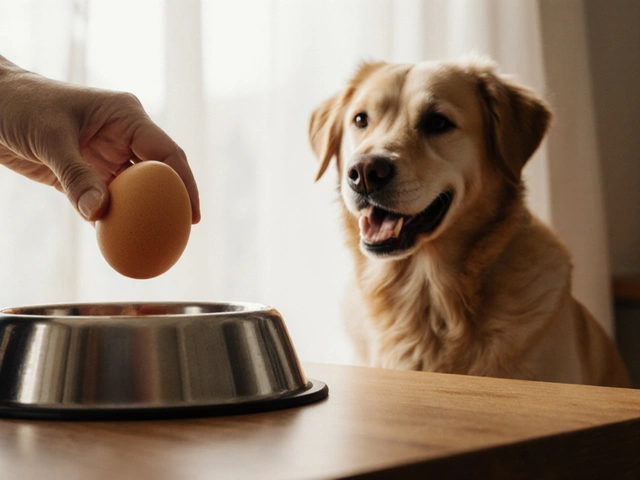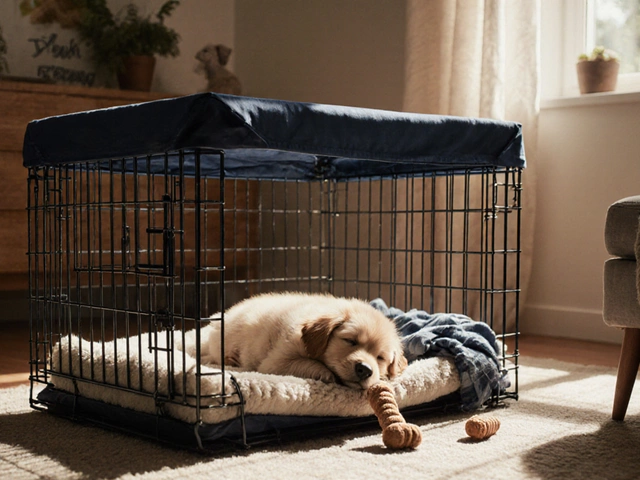
Most dog owners don’t think much about when their dog goes to bed-until the dog starts pacing at 2 a.m. or wakes them up at 5 a.m. with a nudge and a whine. But just like humans, dogs thrive on routine. The best time to put a dog to bed isn’t random. It’s tied to their natural rhythms, your household schedule, and how much activity they’ve had during the day.
Your Dog’s Sleep Needs Are Real
Dogs sleep an average of 12 to 14 hours a day. Puppies, seniors, and larger breeds can sleep up to 18 to 20 hours. That’s not laziness-it’s biology. Their bodies need rest to repair muscles, process memories, and regulate hormones. But unlike humans, dogs don’t sleep in one long block. They cycle through short bursts of deep sleep and lighter dozing. That’s why you’ll see your dog suddenly bolt up, sniff the air, then flop down again. It’s normal.
But here’s the catch: if your dog’s sleep schedule doesn’t match yours, you’ll both suffer. A dog that goes to bed at midnight will wake you at 3 a.m. if they need to go out. A dog that naps all afternoon won’t sleep through the night. The goal isn’t to force them into your schedule-it’s to sync yours with theirs.
When Should You Put Your Dog to Bed?
The best time to put your dog to bed is 30 to 60 minutes after their last meal and after their final potty break. That’s the sweet spot.
Why? Because digestion slows down after eating, and a full stomach can cause discomfort or the need to go out. If you feed your dog dinner at 6 p.m., aim to settle them in by 7 p.m. to 7:30 p.m. That gives them time to digest, stretch, and relieve themselves before settling in.
Most households follow a pattern: dinner around 6 p.m., a short walk or play session, then quiet time. That’s your cue. After the last potty break, dim the lights, turn off the TV, and head to your dog’s bed. Don’t wait until you’re ready for bed yourself. If you’re scrolling on your phone at 10 p.m., your dog has been waiting for hours.
Consistency Is the Key
Dogs don’t have calendars or clocks, but they’re experts at reading patterns. If you put them to bed at 8 p.m. on weekdays and 11 p.m. on weekends, they’ll be confused-and likely restless. Their internal clock gets set by repetition. The same time every day, every night, builds trust and predictability.
Think of it like this: if you went to bed at a different time every night, you’d feel off. Your dog feels the same way. A 2023 study from the University of Auckland’s Veterinary Behavior Lab found that dogs with consistent bedtime routines showed 40% less nighttime anxiety and 30% fewer disruptions in sleep cycles compared to those with erratic schedules.
Start simple. Pick a time that works for your life-early enough that you’re not rushing, late enough that your dog has burned off energy. Stick to it. Even on weekends. Even if you’re tired. Your dog will thank you with quiet, restful nights.

What About Puppies?
Puppies are the hardest. They have tiny bladders and need to go out every 2 to 4 hours. A 10-week-old puppy might need to pee at 10 p.m., 1 a.m., and 4 a.m. That’s not a behavior problem-it’s physiology.
Here’s how to handle it: set a bedtime around 9 p.m. Take them out right before bed. Then, set an alarm for 1 a.m. and take them out again. After a few weeks, move the alarm to 2 a.m., then 3 a.m. Most puppies can sleep through by 4 to 6 months. But only if you train them with consistency.
Don’t skip the 1 a.m. walk. If you let them cry it out, they’ll learn that whining gets attention-but not always when you want it. A scheduled potty break teaches them to hold it, not to scream for it.
The Dog Bed Matters Too
Putting your dog to bed at the right time won’t help if their bed is uncomfortable. A hard floor, a thin mat, or a bed that’s too small will keep them awake. Dogs need support-especially older dogs with arthritis or large breeds with joint stress.
Look for a bed with orthopedic foam, raised edges for leaning, and washable covers. Place it in a quiet corner, away from drafts and loud appliances. Some dogs like enclosed beds that feel like dens. Others prefer open ones where they can see the room. Watch your dog. Do they circle for 10 minutes before lying down? That’s a sign they’re trying to get comfortable. A better bed fixes that.
Don’t just buy the cheapest one. A good dog bed costs $50 to $100-but it lasts years and improves sleep quality for both of you.

What If Your Dog Won’t Sleep?
If your dog is still restless after following the routine, look at these common issues:
- Too much evening stimulation-running around, rough play, or watching TV right before bed keeps their brain wired. Swap playtime for quiet petting or a slow sniffing game with a treat-dispensing toy.
- Not enough daytime exercise-a dog that’s bored or under-stimulated at night will burn energy pacing. A 30-minute walk in the morning and another in the evening makes a big difference.
- Separation anxiety-if your dog whines or scratches at your bedroom door, they may be stressed when you’re out of sight. Try leaving a piece of your clothing near their bed. Some dogs sleep better with a white noise machine or calming pheromone diffuser.
- Medical issues-if your dog suddenly changes sleep habits, especially if they’re older, check with your vet. Pain, thyroid problems, or cognitive decline can disrupt sleep.
Final Tip: Make It a Ritual
Turn bedtime into a calm, predictable ritual. Same time. Same route to the bed. Same soft words. Same gentle pat. No yelling. No last-minute treats. Just quiet consistency.
Your dog doesn’t need fancy tricks. They need to know what comes next. When they feel safe and understood, they settle faster. And when they sleep better, so do you.
Start tonight. Feed dinner at 6 p.m. Take the last walk at 7 p.m. Be in bed by 7:30 p.m. with your dog beside you. Watch how the quiet grows. How the rest deepens. How the 3 a.m. wake-ups fade away.
It’s not magic. It’s just routine. And for dogs, that’s everything.





